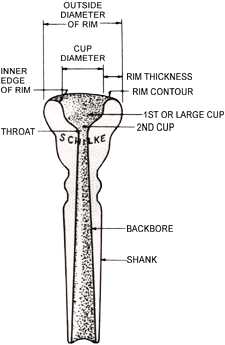from the Schilke mouthpiece brochure
Editor's note: The Schilke mouthpiece labeling system was invented and developed by Will Scarlett, one of the first employees of Schilke Music Products, Inc. He worked primarily in the office until he secured a position in the trumpet section of the Chicago Symphony, where he played from 1964 until his recent retirement.

The first number refers to the cup diameter; smaller numbers have smallest diameters. Most trumpet and cornet mouthpieces have a cup diameter that falls between .600 inch and .725 inch. Nos. 1 to 25 in the Schilke system represent sections of .005 inches each between these two measurements.
The first letter refers to the cup volume.
|
|
|
|
|
|
|
|
(medium size) |
|
|
|
|
|
|
In general the deep cup mouthpieces produce the darkest sounds. In reverse the shallow cup mouthpieces produce the brightest sounds and also aid in the production of the high register. The Schilke "C" cup is a compromise which offers both full tone and ease of production.
In switching from one instrument to another, i.e., B flat trumpet to D trumpet, it is usually good to use a mouthpiece that is .025 inch shallower in the cup volume with all other dimensions remaining the same. The higher the instrument is, the shallower the cup should be.
A player who needs primarily a good range without sacrificing much tone can consider a shallow mouthpiece with a widened second cup. The shallow first cup affords support in the top register and the widened second allows a full tone.
The second (last) number refers to the rim contour.
|
|
|
|
|
|
|
|
|
|
|
|
|
|
|
The #3 Schilke rim has the feel that most players prefer in a rim. It has flat enough contour to distribute the slight pressure needed to provide an air seal but is rounded slightly to offer increased flexibility. Generally a rounder rim will allow greater flexibility but sometimes tires the player sooner. A flat rim often feels the most comfortable but tends to hold the lips in a fixed position, thereby reducing flexibility.
The second (last) letter refers to the backbore.
|
|
|
|
|
|
|
|
|
|
|
|
|
|
|
Schilke mouthpieces all come with standard backbores ("c") which permit the maximum in tone and range. Other backbores are available (letters a, b, d, e) which might suit particular needs of players. The tighter backbores tend to make the sound more brilliant while the larger backbores tend to make the sound more mellow. Occasionally a change in backbores will cause an alternation in intonation which often can correct faulty intonation of an instrument.
The fit of the mouthpiece
The shank of every brass mouthpiece when in the instrument should touch the end of the mouthpipe to insure an even taper from the backbore of the mouthpiece to the inside of the mouthpipe.
Dirt in the mouthpiece
Dirt inside the throat or backbore of a mouthpiece can greatly alter the intonation of the instrument on which it is used. Mouthpieces can only be kept clean with a mouthpiece brush used every week.
Editor's note: In addition to designs and sizes above, there are a few other more extreme sizes or components available as a custom order.
The first is a very narrow backbore labelled the "aa," and nicknamed "the zinger" around the Schilke shop for obvious reasons.
In addition, the flugelhorn cup can also be ordered on a trumpet or cornet mouthpiece blank. These are designated "F" cups, a deep V shaped cup, for those wishing the darkest mellowest trumpet (or cornet) tone available. I happen to have a 15F that I found on eBay one day.
There is also a star (*) cup design, it has the approximate depth of an "A" cup, very shallow, but the it is more radically bowl shaped and maks it more difficult for players to 'bottom out,' where they lips hit the bottom of the cup and cease vibrating. I believe that Scott Laskey designed the star (*) cup and he has continued it as part of his mouthipieces designs for the Laskey Company.